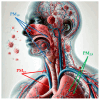Ambient Air Pollution and Congenital Heart Disease: Updated Evidence and Future Challenges
- PMID: 39857382
- PMCID: PMC11761577
- DOI: 10.3390/antiox14010048
Ambient Air Pollution and Congenital Heart Disease: Updated Evidence and Future Challenges
Abstract
Congenital heart disease (CHD) represents the major cause of infant mortality related to congenital anomalies globally. The etiology of CHD is mostly multifactorial, with environmental determinants, including maternal exposure to ambient air pollutants, assumed to contribute to CHD development. While particulate matter (PM) is responsible for millions of premature deaths every year, overall ambient air pollutants (PM, nitrogen and sulfur dioxide, ozone, and carbon monoxide) are known to increase the risk of adverse pregnancy outcomes. In this literature review, we provide an overview regarding the updated evidence related to the association between maternal exposure to outdoor air pollutants and CHD occurrence, also exploring the underlying biological mechanisms from human and experimental studies. With the exception of PM, for which there is currently moderate evidence of its positive association with overall CHD risk following exposure during the periconception and throughout pregnancy, and for ozone which shows a signal of association with increased risk of pooled CHD and certain CHD subtypes in the periconceptional period, for the other pollutants, the data are inconsistent, and no conclusion can be drawn about their role in CHD onset. Future epidemiological cohort studies in countries with different degree of air pollution and experimental research on animal models are warranted to gain a comprehensive picture of the possible involvement of ambient air pollutants in CHD etiopathogenesis. While on the one hand this information could also be useful for timely intervention to reduce the risk of CHD, on the other hand, it is mandatory to scale up the use of technologies for pollutant monitoring, as well as the use of Artificial Intelligence for data analysis to identify the non-linear relationships that will eventually exist between environmental and clinical variables.
Keywords: Artificial Intelligence; Internet of Things; ambient air pollution; carbon monoxide; congenital heart disease; maternal exposure; nitrogen dioxide; ozone; particulate matter; sulfur dioxide.
Conflict of interest statement
The authors declare no conflicts of interest.
Figures



Similar articles
-
Mortality and Morbidity Effects of Long-Term Exposure to Low-Level PM2.5, BC, NO2, and O3: An Analysis of European Cohorts in the ELAPSE Project.Res Rep Health Eff Inst. 2021 Sep;2021(208):1-127. Res Rep Health Eff Inst. 2021. PMID: 36106702 Free PMC article.
-
Risk of maternal exposure to mixed air pollutants during pregnancy for congenital heart diseases in offspring.Zhejiang Da Xue Xue Bao Yi Xue Ban. 2022 Jun 25;51(3):326-333. doi: 10.3724/zdxbyxb-2022-0073. Zhejiang Da Xue Xue Bao Yi Xue Ban. 2022. PMID: 36207835 Free PMC article. English.
-
Maternal exposure to ambient air pollution and congenital heart defects in China.Environ Int. 2021 Aug;153:106548. doi: 10.1016/j.envint.2021.106548. Epub 2021 Apr 7. Environ Int. 2021. PMID: 33838617
-
Prenatal exposure to ambient air pollutants and congenital heart defects: An umbrella review.Environ Int. 2023 Aug;178:108076. doi: 10.1016/j.envint.2023.108076. Epub 2023 Jun 30. Environ Int. 2023. PMID: 37454629
-
Ambient air pollution and pregnancy outcomes: A comprehensive review and identification of environmental public health challenges.Environ Res. 2018 Nov;167:144-159. doi: 10.1016/j.envres.2018.07.008. Epub 2018 Jul 5. Environ Res. 2018. PMID: 30014896 Review.
Cited by
-
The Impact of Arsenic, Cadmium, Lead, Mercury, and Thallium Exposure on the Cardiovascular System and Oxidative Mechanisms in Children.Curr Issues Mol Biol. 2025 Jun 25;47(7):483. doi: 10.3390/cimb47070483. Curr Issues Mol Biol. 2025. PMID: 40728952 Free PMC article. Review.
References
-
- Abdul-Khaliq H., Gomes D., Meyer S., von Kries R., Wagenpfeil S., Pfeifer J., Poryo M. Trends of mortality rate in patients with congenital heart defects in Germany-analysis of nationwide data of the Federal Statistical Office of Germany. Clin. Res. Cardiol. 2024;113:750–760. doi: 10.1007/s00392-023-02370-6. - DOI - PMC - PubMed
-
- Su Z., Zou Z., Hay S.I., Liu Y., Li S., Chen H., Naghavi M., Zimmerman M.S., Martin G.R., Wilner L.B., et al. Global, regional, and national time trends in mortality for congenital heart disease, 1990–2019: An age-period-cohort analysis for the Global Burden of Disease 2019 study. EClinicalMedicine. 2022;43:101249. doi: 10.1016/j.eclinm.2021.101249. - DOI - PMC - PubMed
-
- Hasan A.A., Abu Lehyah N.A.A., Al Tarawneh M.K., Abbad M.Y., Fraijat A.G., Al-Jammal R.A., Moamar D.M., Shersheer Q.A., Guthrie S.O., Starnes J.R. Incidence and types of congenital heart disease at a referral hospital in Jordan: Retrospective study from a tertiary center. Front. Pediatr. 2023;11:1261130. doi: 10.3389/fped.2023.1261130. - DOI - PMC - PubMed
Publication types
LinkOut - more resources
Full Text Sources

